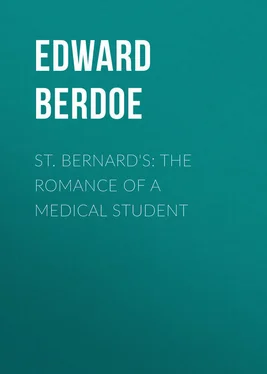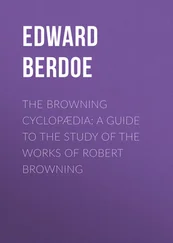Edward Berdoe - St. Bernard's - The Romance of a Medical Student
Здесь есть возможность читать онлайн «Edward Berdoe - St. Bernard's - The Romance of a Medical Student» — ознакомительный отрывок электронной книги совершенно бесплатно, а после прочтения отрывка купить полную версию. В некоторых случаях можно слушать аудио, скачать через торрент в формате fb2 и присутствует краткое содержание. Издательство: Иностранный паблик, Жанр: foreign_antique, foreign_prose, на английском языке. Описание произведения, (предисловие) а так же отзывы посетителей доступны на портале библиотеки ЛибКат.
- Название:St. Bernard's: The Romance of a Medical Student
- Автор:
- Издательство:Иностранный паблик
- Жанр:
- Год:неизвестен
- ISBN:нет данных
- Рейтинг книги:4 / 5. Голосов: 1
-
Избранное:Добавить в избранное
- Отзывы:
-
Ваша оценка:
- 80
- 1
- 2
- 3
- 4
- 5
St. Bernard's: The Romance of a Medical Student: краткое содержание, описание и аннотация
Предлагаем к чтению аннотацию, описание, краткое содержание или предисловие (зависит от того, что написал сам автор книги «St. Bernard's: The Romance of a Medical Student»). Если вы не нашли необходимую информацию о книге — напишите в комментариях, мы постараемся отыскать её.
St. Bernard's: The Romance of a Medical Student — читать онлайн ознакомительный отрывок
Ниже представлен текст книги, разбитый по страницам. Система сохранения места последней прочитанной страницы, позволяет с удобством читать онлайн бесплатно книгу «St. Bernard's: The Romance of a Medical Student», без необходимости каждый раз заново искать на чём Вы остановились. Поставьте закладку, и сможете в любой момент перейти на страницу, на которой закончили чтение.
Интервал:
Закладка:
Let us enter into the dissecting room of St. Bernard’s, and see how our future doctors learn to deal with the ailments our flesh is heir to. It is a spacious chamber, some fifty feet long by thirty feet wide; its floor is slate, cold, and non-absorbent; its walls half-way up of the same impervious material; it has no windows, but is lighted by a glass roof and many gas jets for dark days. On either side are eight strong tables, on each of which lies a corpse. Round each table are several heavy, well-made stools; they need be heavy. They are often subject to rough usage at the hands of their occupants when not engaged in more scientific work.
On this first of October, all the “subjects,” as they are technically called, are untouched by the knife; in a few days they will scarcely be recognisable as having ever been our brothers and sisters of the mortal life. The busy scalpel of the anatomy student will be engaged on every limb and feature in “getting out,” as it is termed, his “part.” Then the observant eye of a man of science would see how fearfully and wonderfully we are made. The Psalmist could have had but a faint idea how much his beautiful phrase conveyed. Here are displayed for us the exquisite sets of muscles and tendons that enable us to move our hands and arms. This part shows the nerve and blood supply of the leg, and that one the machinery by which we smile, laugh, or express our wonder and surprise. Here is a man at work seeking to unfold the marvellous convolutions of the brain, while at another table one has got down to the articulations of the foot, and is showing the pulleys and joints that enable us to walk. The art of anatomical dissection consists in freeing the muscles, tendons, arteries, veins, and nerves from the surrounding fat and connective tissue which in the living body preserves and covers them.
It is absolutely necessary that the student should not only know from books, but actually see with his own eyes, and for a long period attentively observe the origin and course of every nerve, artery, and vein which in the whole body is capable of being dissected out. He must know the exact position of all the muscles, how they move the bones, how they extend or flex the limbs, what nerves supply them with motive power, and how that nerve takes its course from the brain or spinal cord. The number of complications is so great that nothing but patient tracing out with forceps and scalpel for himself will ever teach a man anatomy.
As an accurate knowledge of this science is the foundation of all medical learning, it is not to be wondered at that the medical schools and examining bodies insist on a very long and careful training in the practical part of this study. So indispensable is it that the schools have never scrupled to obtain subjects for dissection when popular prejudice stinted the supply, by foul means when fair did not avail. No questions were asked in the old days, before the passing of the Anatomy Act, how the “subject” was procured; enough that it was on the table for the uses of science. Whether murder had brought it there, or the visitation of the graveyard by the body-snatcher, nobody concerned in teaching or learning anatomy cared a jot.
In one famous school there was a private trap through which the corpse was pushed into the porter’s room, he passing the money out to the persons who delivered the body, and holding no communication with the body-snatcher, or even seeing his face. Things, however, are different now, and the workhouses are permitted to send the bodies of friendless and unclaimed paupers, whom nobody owns or cares to bury, for the purposes of dissection.
Dissection and the making of a post-mortem examination, though often confounded in the public mind, differ materially. Dissection consists in minutely tracing out all the important structures of the limbs, body, and vital organs, and thus it takes several weeks’ hard work to get through a whole subject; while a post-mortem examination is the labour of an hour or two, and consists in examining and noting the pathological conditions of the internal organs, with a view merely to discovering the cause of death. An adult subject is worth about £5 when properly prepared for research. Each arm and leg, the half of the head, the chest, and the rest of the trunk, was charged to the student requiring it at St. Bernard’s, 12 s. 6 d. , and he was expected to make good use of his opportunity. Every portion removed by his scalpel was carefully gathered up by a porter, and every night and morning placed in a coffin in the vaults below. When a coffin is filled with this minutely divided humanity, it is sent to a cemetery and buried as “our brethren and sisters departed.” The provisions of the Anatomy Act forbid the taking of any portion of the subjects out of the schools; nevertheless more than one ardent student whom we see in the room will finish his work on the hand or the foot at his own lodgings, to the horror and disgust of his landlady if she catches him at it.
Some men never make good dissectors; they can cram up what they want for their examinations without the infinite pains required for a beautiful “preparation” such as is being made at this table on our right for the college museum. It is an arm, and every muscle stands out clean and clear, every artery is seen with its vermilion wax injection running its sharply defined course, and anastomosing with its neighbouring vessels. Here are the nerves like silver threads, becoming, like the blood supply, smaller as they reach the fingers, till they are lost in their terminations at the tips. It requires a man with a special genius, and the gift of an infinite capacity for taking pains, to do work like this, and many take a pride in doing it.
Round this table on the left is a group of junior students, listening to the demonstrator, who is lecturing on the muscles of the chest, or thorax as it is called, and asking each of his auditors in turn some question to test his knowledge, and explain his difficulties if he have any.
The coloured diagrams round the walls, and the illustrations in the text-books used, serve to complete our acquaintance with the matter in hand, and its daily repetition fixes it in the memory. The men do their work in great linen blouses or aprons with sleeves. Most of them smoke, and the dissecting-room certainly is one place from which the most violent anti-tobacco agitator would hardly wish to banish it, if he knew how it mitigates its awful odours. When the morning is over, and the men have taken their lunch (they eat sandwiches at their work without the least fastidiousness), few of them return for any more work in that place unless they chance to be very industrious. There are some few men who, in their first and second year, dissect on every available opportunity; for anatomy cannot be crammed, and can only be mastered by this persistent business of the scalpel. Occasionally a visitor will drop in to look round at the work going on; some general practitioner who has been at the school in his early days, to refresh his memory on some point, or to rekindle for a few moments the lost enthusiasm in such studies. Often they tell good stories of the difficulties they had in the olden time of procuring bodies. One old fellow who had been a demonstrator in that room, told one day how, on one occasion some fifty years before, he had been urging the beadle to provide more subjects.
“Can’t get you a fresh ’un before this day week, sir,” replied the man. “You see, sir, it is my mother-in-law. She only died last night. She will be buried on Thursday. We’ll have her up the same night, and she’ll be ready next morning for you.”
And then he related how the body-snatchers went to Bow Cemetery, then almost out in the country, and “resurrected” the poor woman, stripped her of her shroud (to take which was felony), put her in a light cart, and drove off with her. On either side of the Bow road at that time were fields; it was very dark and lonely. When half-way towards their destination they feared they were closely pursued, and to avoid a capture they cast the body out into the ditch, and made off with all haste. Next morning there was a report of a horrible murder. An inquest followed, and an open verdict was returned, name and cause of death unknown.
Читать дальшеИнтервал:
Закладка:
Похожие книги на «St. Bernard's: The Romance of a Medical Student»
Представляем Вашему вниманию похожие книги на «St. Bernard's: The Romance of a Medical Student» списком для выбора. Мы отобрали схожую по названию и смыслу литературу в надежде предоставить читателям больше вариантов отыскать новые, интересные, ещё непрочитанные произведения.
Обсуждение, отзывы о книге «St. Bernard's: The Romance of a Medical Student» и просто собственные мнения читателей. Оставьте ваши комментарии, напишите, что Вы думаете о произведении, его смысле или главных героях. Укажите что конкретно понравилось, а что нет, и почему Вы так считаете.












